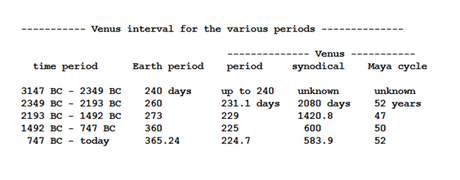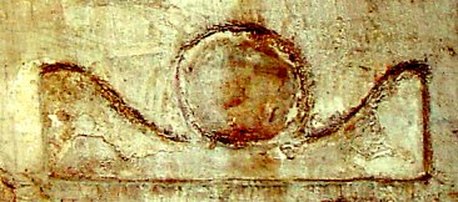Imitative Invocations of the Gods
c. -2750 to -2349
Pyramids & Mounds
As above, so below. As gods once did, so does man do. Soon after the departure of the kingly glowing 'pyramids' from the skies above, an untold number of cultures worldwide began building pyramids here below.
Jupiter's glowing bifurcated "mountain" shrunk to a knotted plasmaform (the 'shen' shape) upon entering the asteroid belt in about -2914 to -2860, roughly in the middle of Mars' 300 years of princely "reincarnations." This would likely have been the form taken by the plasma outpouring from Jupiter's magnetic north / geographical south pole upon cycling and blasting his way thro the debris field of the asteroid belt, extending directly left and right and curved up further away. These are the "ram horns" of 'Amun-Re,' also depicted as a "boat" or "sun-barque" extensively in antiquity.
About 110 (to 150?) years later, when the slowly circularizing orbital ellipses of Mars attained a newer phase of dynamic equilibrium, the second nodal point of its elliptical orbit having been torqued away from Earth, Mars' plasma "mountain" was no longer seen gracing the Earth with his "holy fire." Earth and Mars would not close in on each other again for another 800 years. (Mercury, however, seems to have continued to regale many peoples from a distance, likely passing "overhead," wrapped in a white windy cloud-cover, with fantastic winglike plumes extruding from both poles.)
In the following century, beginning no later about -2650, peoples throughout the world began constructing mountains of chalk and pyramids of stone in the image of of the disappeared "mountains" of Mars and Jupiter (remembrance of the former dome of the Primal Mound was also likely a component in most locations), all within a hundred years of each other -- in Egypt, Mesopotamia, England, China, in the Andes of South America, and in many other locations, such as Greece and the Balkans. (Cook, Chapter 2)
"The constructions were an indication that the primary image had disappeared, and typically, the humans felt that it was up to them to induce the return of the God." (Cook, Appendix B) Pyramids, ziggurats and mounds were means whereby our ancestors localized (and thereby immanentized) contemporaneous celestial activities of the "gods." (Following in the wake of trailblazers like mythologists Frazer and Eliade, the work of Rens van der Sluijs lately also serves to illustrates this.) These massive monumental commemorations became the foundations for much of the later "symbolizing" retained to this day by our contemporary religions and sociopolitical mores.
About 110 (to 150?) years later, when the slowly circularizing orbital ellipses of Mars attained a newer phase of dynamic equilibrium, the second nodal point of its elliptical orbit having been torqued away from Earth, Mars' plasma "mountain" was no longer seen gracing the Earth with his "holy fire." Earth and Mars would not close in on each other again for another 800 years. (Mercury, however, seems to have continued to regale many peoples from a distance, likely passing "overhead," wrapped in a white windy cloud-cover, with fantastic winglike plumes extruding from both poles.)
In the following century, beginning no later about -2650, peoples throughout the world began constructing mountains of chalk and pyramids of stone in the image of of the disappeared "mountains" of Mars and Jupiter (remembrance of the former dome of the Primal Mound was also likely a component in most locations), all within a hundred years of each other -- in Egypt, Mesopotamia, England, China, in the Andes of South America, and in many other locations, such as Greece and the Balkans. (Cook, Chapter 2)
"The constructions were an indication that the primary image had disappeared, and typically, the humans felt that it was up to them to induce the return of the God." (Cook, Appendix B) Pyramids, ziggurats and mounds were means whereby our ancestors localized (and thereby immanentized) contemporaneous celestial activities of the "gods." (Following in the wake of trailblazers like mythologists Frazer and Eliade, the work of Rens van der Sluijs lately also serves to illustrates this.) These massive monumental commemorations became the foundations for much of the later "symbolizing" retained to this day by our contemporary religions and sociopolitical mores.
|
Egypt
The construction and decoration of pyramids begins with the following 3rd Dynasty of Egypt, within 50 to 100 years after the final close approach of Mars (as reigning king 'Horus'), thus by approximately -2650. Recent satellite-based discoveries of potentially older pyramids in Egypt may push this date back closer to the actual 'Horus' fly-bys.
Uruk, Mesopotamia
The first ziggurats were built in Uruk some time after the dynasty of Kish was conquered and "the kingship was taken to E-ana" (c. -2768 to -2740?). 'E-ana' was the '(Red or White?) Temple' of Inanna that sat atop a ziggurat in Uruk. The Red Temple seems to have been built earlier than the White. Their design is mythohistorically ascribed to Gilgamesh, who was regarded as a kingly incarnation of the "Sky-God" Mars. After Gilgamesh, the references to godlike "kings" cease.
Chinese "Gold Prism Tower / Horn-Drill"
There are at least three meanings of the term “pyramid” in China:
1. Jin’ zi ta – is the most used. Jin means gold. Zi – a mark, hieroglyph, written symbol. Ta – a tower. The hieroglyph Zi [seems to refer back to] the meaning of Jin. [...] [The]hieroglyph Jin has a form of triangle on the top. Therefore “pyramid” in Chinese is “a tower which looks like the gold [triangle] hieroglyph” (literally, "gold [triangle] tower"). 2. The second [most common] meaning of “pyramid” in China is Jiao zhui, the literal translation [of which] is “a horn for drilling the ground." 3. The third [most common] meaning is Leng zhu and can be translated as “prism”. [...] [T]he prism is not simply “a solid object with ends that are parallel and of the same size and shape, and with sides whose opposite edges are equal and parallel," it’s also an optical lens which reflects light. [Mars' ponderous pyramid of plasma plumes was likely rather 'prismatic' in color and appearance.] Venus Redux
The slow circularization of Venus' new solar orbit eventually brought her into several near-Earth transits, the first possibly as early as c. -2453. Roughly 52 years later, c. -2401, a second striking fly-by may have suggested the initial Olmec "Venus head," as well as the 52-year-interval of their Venus count calendar. The third Venus fly-by of this sequence, in c. -2349, would become the most disastrous catastrophe since the encounter with Jupiter in c. -3147.
Venus seems to have been sighted in Mesopotamia as well. After kingship was brought back to Kish again, Ku-Bau, the innkeeper, she who made firm the foundations of Kish, ruled for 100 years as`king' before Kish was defeated. 'Ku-Bau' the innkeeper was also regarded as a"barmaid" and/or "prostitute." Her reign seems to predate Sargon's conquest of Mesopotamia, begun soon after c. -2349. Thus Ku-Bau's mythohistorical 100 year reign may be identical to the 104 years counted in Mesoamerica -- the period of two striking Venus transits immediately preceding the catastrophe of c. -2349.
The 'Double Doors of the Horizon'
Near the equinoxes the Earth's shadow on her equatorial rings (in Egypt known as the Duat) would extend all the way across the rings from bottom to top. Because at this time the penumbra, the widening soft shadow of Earth, also fell on the rings, the shadowed area would be shaped like an inverted parallelogram. (In Mesoamerica the ballcourt, constructed between two sloping walls, is a physical representation of the south sky at night seen at the equinoxes).
In Egypt the godform 'Re' (Jupiter) is often depicted after this time as a giant red globe located in a mountain saddle -- a valley between two mountains composed of ridges (the akhet). The massive pylons used as the gates to later Egyptian temples are meant to represent the left and right edges of the rings as defined by the shadow of Earth filling the space in between, where the spectacular sight of the 'Midnight Sun' would sometimes be seen perfectly framed. (Cook, Chapter 5) |
Caral-Supe, Peru
The construction of pyramids starts in the Andes -- courtesy the Norte Chico culture centered at Caral-Supe, Peru -- at the same time, c. -2627 to -2556.
Dates for Peruvian pyramids are from Carbon-14 dates of baskets left behind with fill material of rocks and pebbles. Caral-Supe is the oldest of some 25 sites in the Norte Chico region of Peru, where other pyramids were started after c. -2556. Initial occupancy of these sites dates closer to -3100 (i.e., after the encounter with Jupiter and the collapse of the Saturnian Polar Stack). Thus the construction of pyramids began some 400 to 500 years after local peoples first occupied the sites. This is identical to what has been uncovered in Egypt, Mesopotamia and elsewhere. In all instances construction of pyramids does not happen until c. -2700. The universality of the human response to these celestial events offers stunning evidence of our trans-cultural commonalities. #(Cook, Appendix A) Silbury Hill, England
Silbury Hill, a giant conical man-made mountain of chalk, is one of the oldest and largest mound in the world, similar in size to the smaller pyramids at Giza. Conventional archeology dates the construction of Silbury Hill to c. -2750, and its gravel core has been conventionally carbon-dated to approximately -2400(+/-50). Like the pyramids at Giza and the Mesopotamian 'White Temple' at Uruk, Silbury Hill was originally brilliant white in appearance. Unique to Silbury Hill, however, is a man-made moat that still regularly floods to this day. Could the moat have represented a particular aspect in the sky, as seen from a field-of-view [#?] miles north of the Levant? Silbury Hill is just south of Avebury, and the two are joined by "old straight tracks" ("ley lines").
Return of Jupiter
Jupiter again developed a brightly glowing coma (tripled in size) after exiting from the asteroid belt, perhaps ushering in the transition from the 4th to the 5th Egyptian dynasty (c. -2550 to -2500). It is then that the Egyptian pharaohs began adding 'Re' to their names. This manifestation of Jupiter likely lasted for roughly 200 years, from about -2527 to -2438.
Because the Earth rotates, the 'Midnight Sun' would be seen rising, riding, and setting on the ecliptic every day or night. The ecliptic is the visual path of Sol also. With its brightly glowing coma, remembered as a "sun-disc," Rex Jupiter was (as Plutarch claimed) visibly three times the diameter of the moon, and thus visibly three times the diameter of the sun. It is quite likely that the reappearing of Jupiter's plasma "mountain" was widely seen as "divine confirmation" or "approval" of pyramid and mound-building; indeed, perhaps as confirmation that the sensibility of 'sympathetic magic' (cf. Frazer) was concretely "true enough" and operatively functional. This would have had a profound effect on the human psyche, effectively accelerating the development of newer and more complex sublimations ("beliefs") atop the already tangled mythohistorical threads. Chinese 'Yao'
'Yao' appears before the "flood of -2350" twice, according to the Annals of Shu. This is likely the appearance from c. -2527 to -2438, as well as the final phase of 'Midnight Sun' Jupiter, from c. -2349 to -2150.
(Mesoamerican) Bolon-ti-ku's "Tears"
The disappearance of Jupiter's plasma 'mountain' seems to have become enshrined as a contextual detail of mythohistorical narratives of events shortly to follow. One such instance is the Mesoamerican 'Bolon-ti-ku,' whom the Chilam Balam reports was "not crying" when the events of c. -2349 unfolded.
(Mesopotamian) Marduk's "Garment"
Marduk, likewise, loses his "garment" shortly before he wars with 'Tiamat.' Cook elaborates: "This would not have been reported, I feel, unless there was very little time between its disappearance and its recovery." #(Cook, Appendix A n8)
|



















